What would be the easiest way to view classes, methods, properties, etc. inside a jar file? I'm looking for something equivalent to the very useful Lutz Roeder .NET Reflector - for Java
-
@KolobCanyon true, but they top rated answer was submitted the same day as this one was asked – Pranav A. Sep 27 '17 at 10:18
-
1The answer comes from: [https://superuser.com/a/808938/1045397](https://superuser.com/a/808938/1045397) You can do it with vim vim file_name.jar – 取一个好的名字 Jun 05 '19 at 01:43
31 Answers
Using the JDK, jar -tf will list the files in the jar. javap will give you more details from a particular class file.
- 13,492
- 1
- 31
- 55
- 145,806
- 30
- 211
- 305
-
3@salvob You don't need the hyphen as it takes after `tar` with the options mandatory. – Tom Hawtin - tackline Jan 12 '17 at 16:51
-
2FYI, You may need to add `C:\Program Files\Java\jdk
\bin` to your system or user PATH environment variable before you can use `jar` as a system command. (Where – Tezra Jul 31 '17 at 14:09is your jdk version-build number. Check it in `C:\Program Files\Java`) -
4
-
1to see the content of a non-class files (like manifest) you would like to do something like this: tar -xOzf test.jar `jar tf test.jar | grep MANIFEST` – mPrinC Sep 22 '17 at 20:28
-
2
I usually open them with 7-Zip... It allows at least to see packages and classes and resources.
Should I need to see methods or fields, I would use Jad but of course, it is better to rely on (good) JavaDoc...
Now, somewhere on SO was mentioned some Eclipse plug-ins, to find in which jar file a class is located, perhaps they can do more (ie. what you requested).
[EDIT] Reference to SO thread. Not what is asked, but somehow related, thus useful: Java: How do I know which jar file to use given a class name?
-
The link to the Jad site has been removed as the URL is parked. It can be still found at https://web.archive.org/web/20080106184313/http://www.kpdus.com/jad.html but Jad is outdated today, anyway. – PhiLho Oct 11 '18 at 09:08
In case someone don't know this already, a JAR file is just a ZIP file that contains the program's classes, resources, etc., and some metadata. You can extract one to see how it's put together.
Hence I am using unzip command which is easy to remember and use.
unzip -l <jar-file-name>.jar
For example, if you have a jar file with name test.jar then unzip -l test.jar will list all the content of jar file.
While all other answers are great, but in most of them, you would have to use some software like 7 zip or JDK or some other eclipse tool while this doesn't require you to have any of these big s/w and it comes by default in linux and mac so its very lightweight and handy to use.
You can also use zipinfo <your jar file>. if your OS supports this.
- 30,756
- 6
- 57
- 88
-
1
-
1If the file explorer supports zip, renaming the jar to .zip works too (for example on windows) – Rhayene Dec 05 '18 at 13:03
What I use personally is JD-GUI. It is a free 'decompiler', as it allows you to see the source code, classes, and objects in the classes, as well as see the file structure in a tree menu to the left. However, it does not allow you to modify the classes directly.
JD-GUI's website: http://jd.benow.ca/
-
This works cross-platform while 7-Zip mentioned in another answer is Windows-specific. – Brad Cupit Dec 02 '15 at 21:09
-
I used *Archive Utility* on OS X, worked fine. Most (un)zip utilities should work, regardless of platform. – Greenonline Dec 18 '15 at 10:58
jar -tvf file_name.jar
above will only print names of the files.
To view the content of files, you can extract the files in a folder by:
jar -xvf file_name.jar
this will unzip jar file & put the content in same directory where you are running this.
Or in Windows rename .jar file to .zip & then you can unzip to extract & view the content of jar file. As jar is internally a zip file.
- 644
- 6
- 19
Method names, fields, etc.
By adding a jar to a project in an IDE, you can usually see methods and field names, but not the detailed implementation. NetBeans can do it, Eclipse probably, IntelliJ probably, etc. You can browse the jar structure directly within the IDE.
Just the contents
For anything such as viewing the contents, you could use :
jar tvf jarfile.jar- winzip or any zip tool
The source code
To access source code, you would use a decompiler such as JAD or one of its frontends or another decompiler. If the code is obfuscated, then ...
- 1
- 1
Extending Tom Hawtin answer, you can pipe the listing to filter out desired class or files:
jar tf my-fat-jar-file.jar | grep filename
This should work on bash/zsh and similars, or emacs' eshell.
Additional information: https://docs.oracle.com/javase/tutorial/deployment/jar/view.html
- 199
- 2
- 4
Use WinRar. It will open the folder structure for you in intact manner. Also allows in-archive editing, while preserving paths.
Afterall, a JAR file is a ZIP archive only.
- 10,899
- 13
- 47
- 49
If you like to see whats inside, simply rename as first option below..
F2 & Rename to jarfile.zip//Use any unzipper...jar tvf jarfile.jarjar tf jarfile.jar
- 4,992
- 19
- 71
- 108
If I understand correctly, you want to see not only classes but also methods, properties and so on. The only tool I know that can do it is Eclipse - if you add a jar to project classpath, you would be able to browse its classes with methods and properties using usual package explorer.
Anyway, this is a good idea for a good standalone Java tool
- 28,280
- 7
- 36
- 32
-
Note that the jar needs to be in "Referenced libraries" folder, not just "libs". And in the case of Apache Commons library, you don't browse the source.jar, you browse the original and then attach the source when Eclipse asks. – Noumenon Aug 26 '13 at 01:07
Jad is klunky and no longer maintained. I've switched to "Java Decompiler", which has a slick UI and support for new language features.
Every decompiler I've used, though, runs into code it doesn't successfully decompile. For those, it helps to understand the disassembled Java byte code produced by the standard JDK tool, javap.
- 265,237
- 58
- 395
- 493
One way to do this is to open the perspective in "Package explorer". Doing this you can see the structure of your jar with class details. For this check the library folder in your project using package explorer.
Window>>Show View>>Other>>Java>>Package Explorer
Another way is, you can use JarPlug as a eclipse plugin. This works in eclipse/springsource
- 720
- 12
- 18
Well, a jar-file is just a zip-file, so if you unzip it (with your favorite unzipping utility), you get all the files inside.
If you want to look inside the class files to see the methods, you'll need a tool for that. As PhiLho mentions, Eclipse is able to do that (by default), and I would think most Java IDEs are capable of that.
- 4,546
- 2
- 17
- 16
My requirement was to view the content of a file (like a property file) inside the jar, without actually extracting the jar. If anyone reached this thread just like me, try this command -
unzip -p myjar.jar myfile.txt
This worked well for me!
- 792
- 5
- 14
This Jar Explorer is good enough.
Supports three decompiler types: JD, Procyon and Fernflower.
Allows to search files and duplicates in any java archive.
Also user can modify jar by D&D files and edit some non-class files.


- 130
- 6
-
Please don't just post some tool or library as an answer. At least demonstrate [how it solves the problem](http://meta.stackoverflow.com/a/251605) in the answer itself. – Das_Geek Nov 15 '19 at 16:09
-
1i always used "jd-gui". i did'nt knew about this. thanks. thanks for info – MbPCM Aug 27 '20 at 15:43
You can view JAR files like ZIP files from Windows Explorer by doing the following:
- Run Command Prompt as Administrator
From the command line, enter:
assoc .jar=CompressedFolder
While you are at it, you might as well do the same for WAR and EAR files:
assoc .war=CompressedFolder
assoc .ear=CompressedFolder
- 53
- 1
- 8
In Eclipse 3.4 do
- Drag the jar file in question into a Java project. A copy of the jar file appears.
- Right click on the jar file, and choose "Build Path" -> "Add to Build Path".
- Jar file is moved to "Referenced Libraries" node, where it can be opened and navigated in the Project Explorer pane.
If seeing source code too is an issue, open a new question.
For navigation on Jar-file level (as a zip file) I use 7zip which works very well, and allows seeing and editing entries which is great for trouble shooting.
- 73,784
- 33
- 194
- 347
Bndtools provides a free JAR viewer plugin for Eclipse.
Add the Eclipse update site and install only the viewer.

- 2,214
- 6
- 33
- 47
You can open them with most decompression utilities these days, then just get something like DJ Java Decompiler if you want to view the source.
I think Java Decomplier is your best option you can download from here: http://jd.benow.ca/

- 1
- 1
- 333
- 1
- 2
- 12
I prefer JAR Browser, it has a simple interface where you can browse multiple JARs, and search for a specific class across multiple JARs simultaneously.
- 1,865
- 16
- 22
Eclipse 3.4 JDT
It is not the quickest way because you have to drag it into your eclipse first. But you will have full java class browsing, even with decompile enabled.
- 24,511
- 12
- 71
- 99
I've set the default action in windows to "Open with WinZip". This makes it easy to manage JARs as archives. You can even add/remove files manually.
- 6,614
- 3
- 25
- 31
Your IDE should also support this. My IDE (SlickeEdit) calls it a "tag library." Simply add a tag library for the jar file, and you should be able to browse the classes and methods in a hierarchical manner.
- 1,292
- 2
- 12
- 21
Most people have answered this correctly here is one solution for linux if you don't even know where your jar path is or your JDK path is different on each host
$(find / -type f -name "jar" 2>&1 |grep '/JDK' |head -1 ) tf FULLY_QUALIFIED_NAME_TO_YOUR_FILE
- 21,260
- 6
- 105
- 81
java -xf some-j.jar will unzip a JAR file.
- 6,313
- 15
- 32
- 40
- 1,030
- 16
- 18